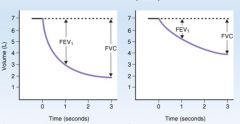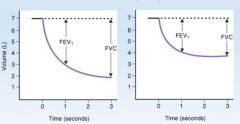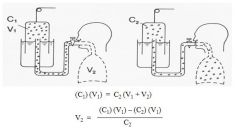![]()
![]()
![]()
Use LEFT and RIGHT arrow keys to navigate between flashcards;
Use UP and DOWN arrow keys to flip the card;
H to show hint;
A reads text to speech;
70 Cards in this Set
- Front
- Back
|
Name the breathing term?
12-14 breaths per minute in a resting individual |
eupnea
|
|
|
Name the breathing term?
respiratory rate greater than 20 breaths per minute |
tachypnea
|
|
|
Name the breathing term?
increase ventilation that is meeting metabolic needs |
hyperpnea
|
|
|
Name the breathing term?
increased ventilation that exceeds metabolic needs |
hyperventilation
|
|
|
Name the breathing term?
respiratory rate less than 10 breaths per minute |
bradypnea
|
|
|
Name the breathing term?
overly slow ventilation |
hypopnea
|
|
|
Name the breathing term?
decreased ventilation that is below metabolic needs |
hypoventilation
|
|
|
Name the breathing term?
labored, difficult breathing |
dyspnea
|
|
|
Name the breathing term?
cessation of breathing |
apnea
|
|
|
name the muscles involved in eupneic breathing?
|
1. diaphragm
2. external intercostals |
|
|
what muscles are involved with dyspneic inspiration in addition to the diaphragm and external intercostals?
|
1. pectoralis minor
2. sternocleidomastoid 3. scalenes |
|
|
what muscles are involved in dyspneic expiration?
|
1. internal intercostals
2. obliques 3. rectus abdominus |
|
|
what component of the lungs is largely responsible for the natural recoil?
|
elastin
|
|
|
describe the pleural covering of the lungs?
|
two layers (visceral and parietal) which form a potential space (pleural cavity) between them
|
|
|
which zones compose the conducting zone?
|
1-16
|
|
|
does the conducting zone contain cilia?
|
yes
|
|
|
does the conducting zone contain smooth muscle and cartilage?
|
yes, but cartilage is only patchy in the bronchi and is completely absent in the bronchioles
|
|
|
what three components make up he conducting zone?
|
1. trachea
2. bronchi 3. bronchioles |
|
|
where is the greatest resistance to airflow found in the lungs?
|
zones 1-7 which is basically trachea and bronchi
|
|
|
what are the 3 functions of the conducting zone?
|
1. control air flow volume
2. warm and humidify air 3. filter air and remove debris |
|
|
which portions of the conducting zone will not have the mucociliary elevator?
|
the oral and laryngeal pharynx
|
|
|
what is the mechanism of action of Ipratropium and what is it used to treat?
|
its an anticholinergic used to block muscarinic receptors on bronchiole smooth muscle and therefor increase airway diameter - used for treatment of airway obstructive diseases like asthma
|
|
|
what percentage of O2 exchange occurs in each zone?
Respiratory bronchioles Alveolar ducts Alveolar sacs |
Respiratory bronchioles = 1%
Alveolar ducts = 10% Alveolar sacs = 90% |
|
|
what zone has the last of the ciliated cells?
|
the respiratory bronchioles
|
|
|
what zone has the last of the smooth muscle?
|
the alveolar ducts
|
|
|
what zone has the last of the cartilage?
|
bronchi
|
|
|
the total lung capacity is made up of which lung volumes?
|
IRV, VT, ERV, RV
|
|
|
the volume of air inspired and expired during a normal breath is called?
|
tidal volume
|
|
|
how much should tidal volume be?
|
500 ml
|
|
|
maximum amount of air that can be inspired at the ends of a normal inspiration is called?
|
inspiratory reserve volume IRV
|
|
|
the maximum amount of air that can be expired after the end of a normal expiration is called?
|
expiratory reserve volume ERV
|
|
|
volume of air remaining in the lungs after forced expiration?
|
residual volume RV
|
|
|
Volume of air in the lungs after a maximal inspiration is called?
|
Total lung capacity (TLC)
|
|
|
Volume of air forcefully expired from lungs after a maximal inspiration is called?
|
Vital capacity (VC)
|
|
|
Volume of air remaining in the lungs after a normal expiration is called?
|
Functional residual capacity (FRC)
|
|
|
Volume of air that can be inspired after a normal expiration is called?
|
Inspiratory capacity (IC)
|
|
|
VT + IRV + ERV + RV=?
|
Total lung capacity (TLC)
|
|
|
VT + IRV + ERV=?
|
Vital capacity (VC)
|
|
|
TLC – RV=?
|
Vital capacity (VC)
|
|
|
ERV + RV=?
|
Functional residual capacity (FRC)
|
|
|
VT + IRV=?
|
Inspiratory capacity (IC)
|
|
|
Volume of air forcefully expired after a maximal inspiration?
|
FVC
|
|
|
what is a normal FVC?
|
5000ml
|
|
|
Volume forcefully expired in the first second is called?
|
FEV1
|
|
|
what is the avg. value for FEV1?
|
3,500 to 4,000 ml
|
|
|
what percentage of air should be expired at FEV3?
|
95%
|
|
|
what percentage of air should be expired at FEV1?
|
70-80%
|
|

Normal is on the left and what abnormal process is displayed on the right?
|
Obstructive lung disease
|
|

normal is on the left and what abnormal lung process is shown on the left?
|
restrictive lung disease
|
|
|
What is the equation for determining the total lung volume using the helium dilution method?
|

Above
|
|
|
what physics law is utilized with a body plethysmograph to determine lung capacity?
|
Boyle's law which states that P1V1=P2V2
|
|
|
what is the equation for compliance?
|
change is volume / change in pressure
|
|
|
what is the normal value for compliance in the lung?
|
.13 liters / cm H2O
|
|
|
why is hysteresis absent in saline filled lungs?
|
it abolishes the gas-liquid interface that is causing surface tension
|
|
|
at FRC what can be said about the lung recoil and the chest wall expansion forces?
|
they are equal
|
|
|
what is LaPlace's law and what is it used to determine?
|

Used to determine pressure of inflation in the alveoli
|
|
|
what is the equation to determine airflow?
|

Reduce resistance increase airflow, increase difference between P1 and P2 and increase airflow
|
|
|
in dry air what is the partial pressure of nitrogen or oxygen? (percentages)
|
1. 79% 600 mm Hg
2. 21% 160 mm Hg |
|
|
what additional significant partial pressure is contributed by water vapor once air is in conducting system?
|
47mm Hg
|
|
|
what condition controls the partial pressure of water vapor?
|
temperature only, not effected by atmospheric pressure
|
|
|
what is the solubility coefficient of water?
|
(.003 ml O2 / 100 ml blood) / mm Hg
|
|
|
what is the solubility coefficient of CO2?
|
(.07 ml O2 / 100 ml blood) / mm Hg
|
|
|
what is Henry's law and what is it use to describe?
|
dissolved gas = (PRESSUREgas) x (solubility coefficient of gas)
amount of gas dissolved in a fluid at a given partial pressure |
|
|
whats the rule of thumb: for determining dead space?
|
volume in ml. is equal to weight in pounds
|
|
|
what are the 2 types of dead space and what is their combined total called?
|
two types are anatomical dead space (conducting zone) and alveolar dead space (alveoli which do not participate in gas exchange for whatever reason)
Together they comprise the physiological dead space |
|
|
what equation allows for the calculation of physiological dead space?
|

As PECO2 increases, Vd decreases. In other words as the dead space decreases you will see more CO2 expired because more gas exchange can occur
|
|
|
according to Fick's law, why does diffusion per unit time decrease in emphysema?
|
the area for diffusion is destroyed which decreases the rate of gas exchange
|
|
|
according to Fick's law, why does diffusion per unit time decrease in pulmonary edema?
|
the distance the gas has to diffuse is greater than normal
|
|
|
starting from the alveoli describe the PaO2 throughout circulation up to the pulmonary artery
|
104 in alveoli -> 95 in pulmonary veins -> 40 in interstitial spaces and venous return -> 20 in cells (mm Hg)
|
|
|
starting from the alveoli describe the PaCO2 throughout circulation up to the pulmonary artery
|
40 in alveoli -> 40 in pulmonary veins -> 45 in interstitial spaces and venous return -> 46 in cells (mm Hg)
|

